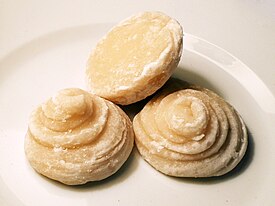Several species of palm provide a fourth source of commercial sugar all of which is only available in the tropics and subtropics. The species utilized are the wild date, Phoenix sylvestris, the palmyra palm, Borassus flabellifer, the coconut, Cocos nucifera, the toddy palm, Caryota urens, and the gomuti palm, Arenya pinnata. Some of the oil palms also yield sugar. The date palm is tapped similar to that of a maple and the sap is obtained from the tender upper portion of the stem. In the other palm species the sap is secured from the unopened inflorescences.
Usually the tip of these is cut off and the sap oozes out and is collected in various containers. The yield of this sweet juice, known as toddy, amounts to 3-4 quarts per day for a period of several months. The sap has a sugar content of about 14 percent. It is boiled down to a syrupy consistency and poured into leaves to cool and then hardens into the crude sugar known as jaggary.
Some of this has reached European markets. Three quarts of juice yield about one pound of sugar. The toddy is often fermented to make the beverage known as arrack. The palm sugar industry is very old in India where over 100,000 tons were still being produced yearly by the mid 1900’s.

Three cakes of commercially produced palm sugar.
Palm sugar was originally made from the sap of the Palmyra palm, the date palm or the sugar date palm. Now it is also made from the sap of Arenga pinnata (sugar palm) and the nipa palm, and may therefore also be sold as "arenga sugar". Palm sugar is often labelled under various other names reflecting the several different species of palm utilised and its wide production area across Africa and Asia. Palm sugar is produced by tapping the sap from the inflorescence of the tree and boiling it down to produce a syrup, which is then sold as is, or allowed to crystallize into various shapes and sizes. In some instances the tree itself is tapped rather than the flowering spikes, but this is an isolated production method. Often the distinction is made between coconut sugar and palm sugar, but this only reflects the different species from which the sugar is sourced, i.e. coconut sugar is produced in an identical way.
Thailand is one place where the distinction is made and the difference is due to palm sugar being produced there from the tree trunk of the sugar palm, whilst coconut sugar is tapped from the inflorescences of the coconut palm. The differences are semantic, as all the sugars under their various names are still produced from the sucrose-rich sap of a palm species- Wikipedia





No comments:
Post a Comment